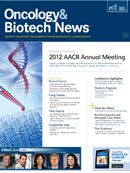Publication
Article
Oncology & Biotech News
Cancer May Cause Prolonged Stress Disorder
Author(s):
More than a third of cancer survivors report ongoing symptoms of posttraumatic stress disorder several years after being diagnosed with cancer.
Sophia K. Smith, PhD
More than a third of cancer survivors report ongoing symptoms of posttraumatic stress disorder (PTSD) several years after being diagnosed with cancer, new results show.
Sophia K. Smith, PhD, Duke University Medical Center, Durham, North Carolina, and coworkers analyzed the results of questionnaires completed by 566 non-Hodgkin lymphoma (NHL) survivors at least 7 years after their diagnosis. The investigators had queried these same patients about 5 years earlier and found that 8% of them satisfied PTSD diagnostic criteria, which included avoidance, arousal, and flashbacks.
The updated survey, conducted at a median of 12.9 years postdiagnosis, found that 37% reported persistent or worsening symptoms. Fifty-one percent of survivors did not have PTSD symptoms at either time point, and 12% had PTSD symptoms at the time of the first survey that had since resolved.
Smith et al said that their study is the largest longitudinal investigation of PTSD symptomatology among adult cancer survivors in the literature to date. A few previous longitudinal studies examined cancer-related PTSD during the first year after a diagnosis, but none had looked at the “trajectory” of cancer-related symptoms in long-term survivors.
Information about possible long-term PTSD symptomatology is especially important in NHL survivors, the researchers noted. Non-Hodgkin lymphoma is one of the most common types of cancer, and treatment advances have increased the 5-year relative survival rate from 31% about 50 years ago to a current rate of 69%.
Results showed that individuals who initially reported a lower income, had aggressive lymphoma, and were stage ≥2 at diagnosis, as well as those who had undergone chemotherapy and reported higher negative and positive scores on the Impact of Cancer scale, version 2, had a greater likelihood of having more PTSD symptoms 5 years later.
The findings of persistent PTSD symptomatology among NHL survivors are akin to those observed among disaster victims and victims of violence.
According to the investigators, the findings of persistent PTSD symptomatology among NHL survivors are akin to those observed among disaster victims and victims of violence. They further noted that their study provides two important messages: “The upfront cancer treatment experience directly influences downstream patient experience and risk of PTSD,” and, “Specific individuals are at increased risk.”
There are currently no established interventions developed specifically for PTSD in NHL survivors. However, clinicians should aim to improve the aspects of the cancer treatment “experience” that cause negative impressions, which may involve the use of physical therapy to improve body image or cognitive behavioral therapy to decrease worry, the researchers said. In addition, given that low-income NHL survivors are at highest risk of long-term PTSD symptoms, it may be worthwhile to triage such patients to social support services.
Smith SK, Zimmerman S, Williams CS, et al. Post-traumatic stress symptoms in long-term non-Hodgkin’s lymphoma survivors: does time heal? J Clin Oncol. 2011;29(34):4526-4533.






%20(2)%201-Recovered-Recovered-Recovered-Recovered-Recovered.jpg?fit=crop&auto=format)

%20(2)%201-Recovered-Recovered-Recovered-Recovered-Recovered.jpg?fit=crop&auto=format)
%20(2)%201-Recovered-Recovered-Recovered-Recovered-Recovered.jpg?fit=crop&auto=format)